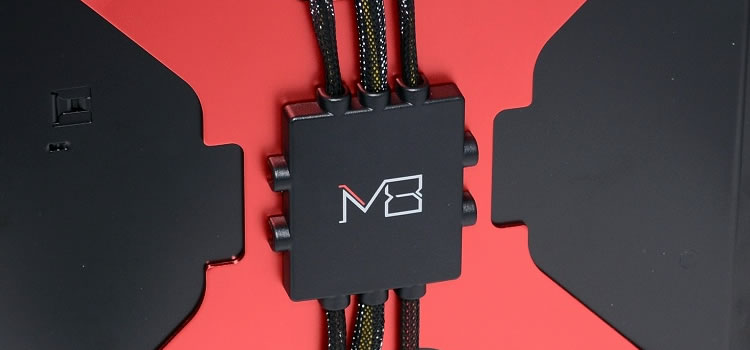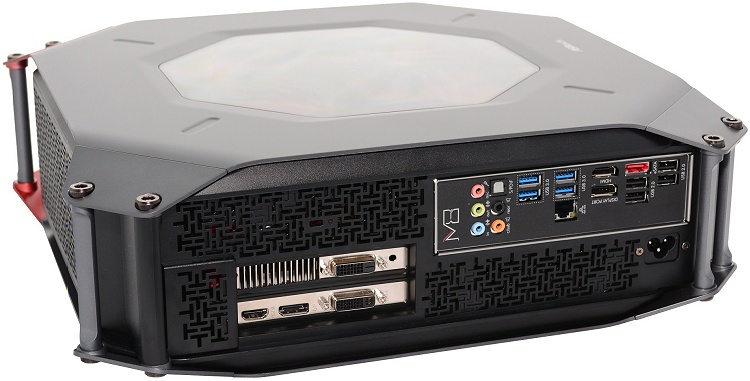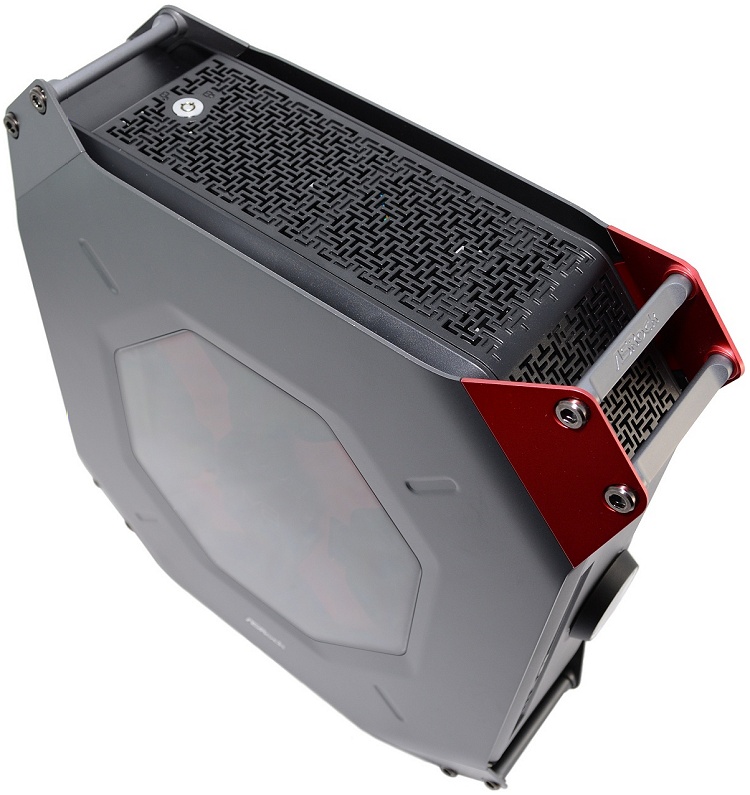Asrock M8 External Design
The M8's external design is what makes it so special – besides measuring only 15.75" long, 14.65" tall and 4.84" wide – and it's where BMW Group DesignworksUSA was most involved. From the front, its most prominent feature is a huge circular power button that is also part of the A-Command feature with an integrated G-sensor.
This multipurpose controller has an OLED panel that shows the system's status along with tuning and overclocking options. I found this feature to be a bit gimmicky, as adjusting things such as the system volume from the front of the case isn't practical or useful to me.
Furthermore, navigating the A-Command menus is clumsy with the dial and much slower than software alternatives. Still, while we didn't find the A-Command button useful, it's not totally pointless for everyone and at the very least, it still looks cool and that's probably most of the original intent anyway.
Alongside the A-Command button are four USB 3.0 ports and a slot-loading optical drive. Of note, while USB 3.0 ports are usually black, Asrock and DesignworksUSA opted for black as it better suites the design.
You might be wondering where the headphone and mic jacks are. Asrock hasn't forgotten about these, but they are hidden at the very bottom of the case behind a small panel that can be flipped down exposing a pair of audio jacks along with the 4-in-1 card reader. It's a very cool design that works much better than a door because if you leave the panel down it looks as though it is meant to be there permanently. When the connectors aren't needed, you can simply press the panel back up into the case.
Although most of the front panel has been constructed from plastic, this certainly doesn't take away from the design in terms of appearance or quality. The highlights have been done in anodized aluminum and these include the small arms found at each corner of the case.
The top of the M8 features another large plastic panel with a unique fan grill that has a series of 'T' shapes that make an interesting pattern.
The back of the grill has a lock to secure the side doors. Once unlocked, the panels can be removed by pulling on them – there are no screws to undo – thanks to magnets embedded in the panels.
The doors are made from 3mm-thick aluminum and have partially transparent windows so that the motherboard and components inside are ambiguously visible, adding a sense of mystery. The right side window, like most of the M8, has been carefully designed. The octagon shape features eight ripples that echo inwards, but off center, creating a very cool effect indeed.
The opposite case door features the same size octagonal window without the ripples, though that isn't to say the design has any less impact, as DesignworksUSA went for a different effect here.
On the rear side of the motherboard there is a large red aluminum 'X' with a black box in the middle labeled M8. Three sleeved power cables run through this box for some creative cable management and it looks great.
The bottom of the M8 has the same creative fan grill found on top, along with a pair of rubber feet that provide the M8 with grip and raise it so the aluminum arms don't touch the ground.
More of the 'T'-style fan grill can be found around back, as well as the I/O shield for the preinstalled Z87-M8 motherboard. There is also a 3-pin power connector, much like those commonly found on laptop power packs, rather than the standard PC power connector.
Most importantly for a gaming machine are the two expansion slots that can accommodate a dual-slot graphics card such as the Radeon R9 270X (HD 7870) or GeForce GTX 760. Notice how they are placed unconventionally in relation to the motherboard's I/O panel? That's because the M8 uses a PCIe x16 riser card.









